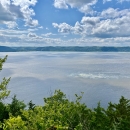About Us
La Crosse Fish and Wildlife Conservation Office was established in 1981 and works to monitor and control the spread of invasive species invasive species
An invasive species is any plant or animal that has spread or been introduced into a new area where they are, or could, cause harm to the environment, economy, or human, animal, or plant health. Their unwelcome presence can destroy ecosystems and cost millions of dollars.
Learn more about invasive species such as invasive carp and round goby as well as restore threatened and endangered freshwater mussels and fish like the Topeka shiner and inter-jurisdictional species like lake sturgeon. The office also provides technical and field expertise to tribal governments in managing their resources, such as assisting in walleye assessments in treaty-ceded territory and restoring lake sturgeon populations of the Red River Basin including the White Earth and Red Lake Nations. Habitat biologists work to restore fish passage fish passage
Fish passage is the ability of fish or other aquatic species to move freely throughout their life to find food, reproduce, and complete their natural migration cycles. Millions of barriers to fish passage across the country are fragmenting habitat and leading to species declines. The U.S. Fish and Wildlife Service's National Fish Passage Program is working to reconnect watersheds to benefit both wildlife and people.
Learn more about fish passage at dams in Minnesota, Wisconsin and Iowa and coordinate habitat conservation projects for the Driftless Area Restoration Effort and Fishers and Farmers Partnership for the Upper Mississippi River Basin under the National Fish Habitat Partnership.
Our Mission
“Working in partnership, we provide leadership in science, technology and education for conservation of aquatic ecosystems emphasizing fisheries, aquatic invasive species invasive species
An invasive species is any plant or animal that has spread or been introduced into a new area where they are, or could, cause harm to the environment, economy, or human, animal, or plant health. Their unwelcome presence can destroy ecosystems and cost millions of dollars.
Learn more about invasive species , genetics and aquatic animal health for the benefit of the public”.
Our History
1995 - La Crosse Fish Health Center and the La Crosse Fish and Wildlife Conservation Office, along with the offices for the Upper Mississippi River National Wildlife and Fish Refuge – La Crosse District, moved to its current location in Onalaska, Wisconsin.
2009 - The first annual youth outdoor fest is held in partnership with La Crosse Parks, Recreation and Forestry.
2013 - The Midwest Fisheries Center was established, housing the Whitney Genetics Laboratory within the La Crosse Fish Health Center along with housing the La Crosse Fish and Wildlife Conservation Office and the Regional Watercraft Safety Coordinator.
2015 - The first Midwest Fisheries Center Director was hired in addition to core administrative and GIS staff.
2018 - The Midwest Fisheries Center lobby was renovated to add more workspace as well as visitor information and displays.
Other Facilities in this Complex
The Midwest Fisheries Center houses the La Crosse Fish Health Center, La Crosse Fish and Wildlife Conservation Office, Whitney Genetics Lab and administrative, GIS and outreach staff, as well as the Regional Watercraft Safety Coordinator.



